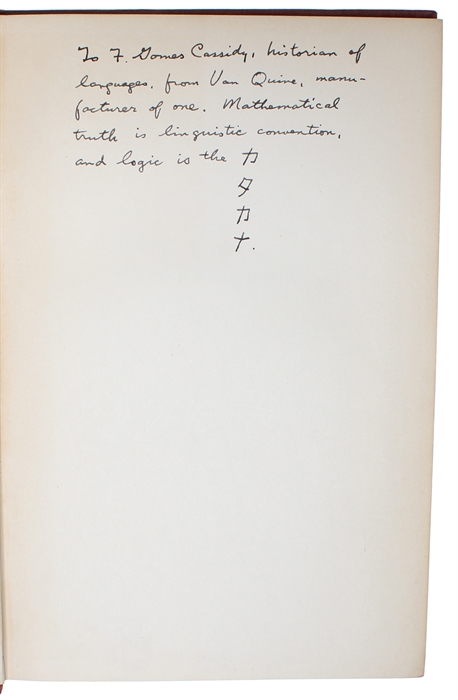MAGNIFICENT PRESENTATION-COPY
QUINE, WILLARD ORMAN VAN.
A System of Logistic.
Cambridge, Massachusetts, Harvard University Press, 1934.
Original full red cloth with gilt line-borders to boards, original dust-jacket, somewhat worn, with a red label over the price and chips and nicks to extremities. Minor loss to corners of dust-jacket, and a large loss of upper part of spine of dust-jacket (ca. 6 x 2 cm), thus lacking the title to spine of dust-jacket, and leaving the cloth of the same part of the spine sunned and the gilding of the title on spine almost faded off. Some soiling to dust-jacket. Internally nice and clean. X, (2), 204 pp.
An excellent presentation copy of this scarce first edition of the great logician's first book, which is the published version of his doctoral thesis, hailed by Whitehead as a landmark in the history of symbolic logic.
Inscribed by Quine "To F. Gomes Cassidy, historian of/ languages, from Van Quine, manu-/ facturer of one. Mathematical/ truth is linguistic convention,/ and logic is the [four Chinese characters]".
Frederic Gomez Cassidy (1907-2000) was a great capacity within wold language scholarship and a close friend of Quine, whom he had known since school and been to Oberlin College with. He was a talented linguist specialized in Early English, Creoles, Lexicography, and American language, who is now primarily famous for his lately begun monumental project, the "Dictionary of American Regional English" (known as DARE). Cassisy was born in Jamaica to a Canadian father and a Jamaican mother and grew up hearing their varieties of standard British English as well as the Cleole variety of the Black majority. When Cassidy was eleven years old, the whole family moved to Ohio. "Here the young Jamaican was introduced to yet another variety of English and was dismayed to learn that it was he who sounded "funny." But that distinction was to have a significant benefit. It piqued the curiosity of a classmate who sought to know and befriend the boy who looked, acted, and sounded so different. That classmate was Willard Van Orman ("Van") Quine, later to become one of America's most distinguished philosophers. The friendship he and Fred began as boys was to last their lifetimes, nourished by shared experiences at Oberlin College, regular correspondence through the decades, and frequent summer hiking trips." (Memorial Resolution of the Faculty of the University of Wisconsin-Madison on the Death of Professor Emeritus Frederic Gomes Cassidy).
The time at Oberlin College was of specific joy to him, and it was here he came to explore his interest in languages, philosophy, and science. He obtained his BA in 1930 and his MA, also at Oberlin, in 1932, and in 1938 he was given his PhD from the University of Michigan.
Quine graduated from Oberlin College in 1930. He then won a scholarship to study for his doctorate at Harvard University, where he wrote the important thesis that was to constitute his first book. Quine's supervisor at Harvard was Alfred North Whitehead, who has also written the Foreword to his first book and who introduced him to Bertrand Russell, who visited Harvard during this time. From then on, Quine kept an ongoing correspondence with Russell. Quine finished his doctorate in two years and was awarded his Ph.D. in philosophy from Harvard in 1932. After that he received a travelling fellowship, which he used to travel to Vienna, where he got acquainted with the members of the Vienna Circle. During his travels he also met Gödel and Ayer. In Warsaw he spent six weeks with Tarski, and in Prague he studied under Carnap, who greatly inspired him. After his year of travelling, he returned to Harvard, where he published the present version of his doctoral dissertation, his first book.
"In this book Dr. Quine has effected an extension of the scope of Symbolic Logic. The advance is more than an improvement in symbols. It extends to fundamental notions. He has introduced a generality adequate to the complexity of the subject matter; and the symbolism embodies the generality of its meaning. I have no hesitation in stating by belief that Dr. Quine's book constitutes a landmark in the history of the subject." So Whitehead writes in his Foreword (p. (IX) ). The logic that Quine takes into consideration is that of Russel and Whitehead's "Principia Mathematica", and when Whitehead towards the end of the Foreword states that "Dr. Quine does not touch upon the relationship of Logic to Metahysics. He keeps strictly within the boundaries of his subject. But - if in conclusion I may venture beyond these limits - the reformation of Logic has an essential reference to Metaphysics. For Logic prescribes the shapes of metaphysical thought" (p. X), the metaphysics he is talking about is nominalism. For Russell and Whitehead, Quine's work represented an unusual illustration of their own logic.
The work was also under much influence of the Polish logicians, and as Whitehead concludes in his Foreword, "it is interesting to note the influence of of the work of Professor H. M. Scheffer, and of the great school of Polish mathematicians. There is continuity in the progress of ordered knowledge." (P. X).
Order-nr.: 37638



